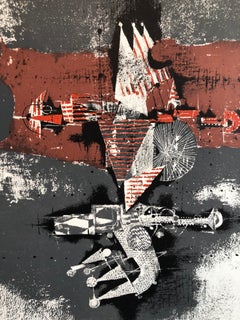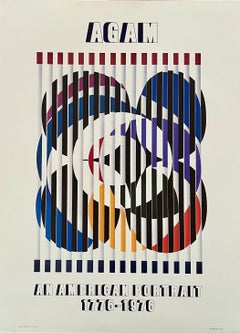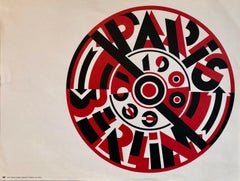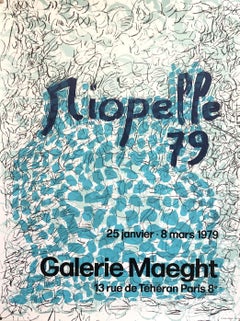Want more images or videos?
Request additional images or videos from the seller
1 of 7
Johnny FriedlaenderLarge Johnny Friedlaender Poster Print No Text
$400List Price
About the Item
- Creator:Johnny Friedlaender (1912 - 1992, Polish)
- Dimensions:Height: 34 in (86.36 cm)Width: 24 in (60.96 cm)
- Medium:
- Movement & Style:
- Period:
- Condition:minor wear. edge wear.
- Gallery Location:Surfside, FL
- Reference Number:1stDibs: LU3823297293
Johnny Friedlaender
Johnny Gotthard Friedlaender was born in Pless (Silesia) and his early studies were in Breslau under Otto Mueller. In 1936 Friedlaender journeyed to Czechoslovakia, Switzerland, Austria, France and Belgium. At the Hague he held a successful exhibition of etchings and watercolours. He fled to Paris in 1937 as a political refugee of the Nazi regime with his young wife, who was an actress. In that year he held an exhibition of his etchings which included the works: L 'Equipe and Matieres et Formes. From 1939 to 1943 he was interned in a series of concentration camps, but survived. After freedom in 1944 Friedlaender began a series of twelve etchings entitled Images du Malheur with Sagile as his publisher. In the same year he received a commission to illustrate four books by Freres Tharaud of the French Academy. In 1945 he performed work for several newspapers including Cavalcade and Carrefour. In 1947, he produced the work Reves Cosmiques, and in that same year he became a member of the Salon de Mai, which position he held until 1969. In the year 1948 he began a friendship with the painter Nicolas de Stael and held his first exhibition in Copenhagen at Galerie Birch. The following year he showed for the first time in Galerie La Hune in Paris. After living in Paris for 13 years, Friedlaender became a French citizen in 1950. Friedlaender expanded his geographic scope in 1951, and exhibited in Tokyo in a modern art show. In the same year he was a participant in the XI Trienale in Milan, Italy. By 1953 he had produced works for a one-man show at the Museum of Neuchâtel and exhibited at the Galerie Moers in Amsterdam, the II Camino Gallery in Rome, in São Paulo, Brazil and in Paris. He was a participant of the French Italian Art Conference in Turin, Italy that same year. Friedlaender accepted an international art award in 1957, becoming the recipient of the Biennial Kakamura Prize in Tokyo. In 1959 he received a teaching post awarded by UNESCO at the Museum of Modern Art in Rio de Janeiro. By 1968, Friedlaender was travelling to Puerto Rico, New York and Washington, D.C. to hold exhibitions. That year he also purchased a home in the Burgundy region of France. 1971 was another year of diverse international travel including shows in Bern, Milan, Paris, Krefeld and again New York. In the latter city he exhibited paintings at the Far Gallery, a venue becoming well known for its patronage of important twentieth century artists. 1978 brought a retrospective of Friedlaender's works at the Musee d'Art Moderne de la Ville de Paris. He was awarded the Lovis Corinth Prize in Regensburg three years later. On his 75th birthday, Friedlaender was given a retrospective in the Bremen Art Museum. On his 80th birthday he held a retrospective exhibition in Bonn at the municipal council offices. Friedlaender died in Paris at the age of 89.
About the Seller
4.9
Platinum Seller
Premium sellers with a 4.7+ rating and 24-hour response times
Established in 1995
1stDibs seller since 2014
1,845 sales on 1stDibs
Typical response time: 1 hour
Authenticity Guarantee
In the unlikely event there’s an issue with an item’s authenticity, contact us within 1 year for a full refund. DetailsMoney-Back Guarantee
If your item is not as described, is damaged in transit, or does not arrive, contact us within 7 days for a full refund. Details24-Hour Cancellation
You have a 24-hour grace period in which to reconsider your purchase, with no questions asked.Vetted Professional Sellers
Our world-class sellers must adhere to strict standards for service and quality, maintaining the integrity of our listings.Price-Match Guarantee
If you find that a seller listed the same item for a lower price elsewhere, we’ll match it.Trusted Global Delivery
Our best-in-class carrier network provides specialized shipping options worldwide, including custom delivery.You May Also Like
The ORIGINAL limited edition 1965 Los Angeles County Museum of Art LACMA poster
By Alexander Calder
Located in New York, NY
Alexander Calder
The original Los Angeles County Museum of Art poster, 1965
Limited Edition vintage Offset Lithograph
32 × 24 3/4 inches 81.3 × 62.9 cm
Edition of 300
This is the OR...
Category
1960s Modern Abstract Prints
Materials
Lithograph, Offset
Poster for Peace
By Robert Rauschenberg
Located in New York, NY
A very good impression of this color offset lithograph with strong colors. Signed, dated and numbered 230/250 in pencil by Rauschenberg. Published by S...
Category
1970s Modern Abstract Prints
Materials
Color, Lithograph, Offset
Original Disques Import Clementine vintage music poster
Located in Spokane, WA
Original linen-backed vintage poster "DISQUES IMPORT CLEMENTINE". Excellent condition. The image with the psychedelic look of the two records that create the eyes and the rest...
Category
1970s Modern Abstract Prints
Materials
Offset
$1,098
H 36.5 in W 24 in D 0.05 in
Untitled
By Louise Nevelson
Located in New York, NY
Very good impressions of these 4 color screenprints on white wove paper. Each signed, dated and numbered 15/25, 18/36, 15/39 or 6/40 in pencil.
Category
1970s Modern Abstract Prints
Materials
Color, Screen
He Repeated the Letters of the Alphabet
By Corita Kent
Located in Missouri, MO
Sister Mary Corita Kent (American, 1918-1986)
He Repeated the Letters of the Alphabet...
Color Screenprint
22.5 x 38.75 inches
Signed Lower Right
Sister Mary Corita Kent, once the n...
Category
Mid-20th Century American Modern Abstract Prints
Materials
Color, Screen
Berlin 2 by Dieter Roth architectural monument postcard in pink of Germany
By Dieter Roth
Located in New York, NY
Berlin 2, 1970
24 x 33.8 in. / 61 x 86 cm
Screen print in one color on offset lithograph, black on white card. Edition 100. “for Paul” written in pencil lower middle: this copy an ar...
Category
1970s Modern Abstract Prints
Materials
Lithograph, Screen
Robert Rauschenberg, rare 1970s Signed/N Earth Day William Burroughs lithograph
By Robert Rauschenberg
Located in New York, NY
ROBERT RAUSCHENBERG
Dream of William Burroughs, 1972
Offset lithograph
34 1/2 × 24 inches
Edition 103/150
Signed, dated and numbered in black marker on the front
Unframed
Wonderful e...
Category
1970s Pop Art Abstract Prints
Materials
Lithograph, Offset
BIG
Located in New York, NY
Artist Proof Print (9/11) 2018
Born in 1979, Denis Meyers is a Belgian urban artist. He studied at the National Superior School of Arts and Visuals of la Cambre, in Brussels, city where he currently lives and works.
Denis Meyers is particularly known for his frescoes and stickers in form of faces, which he calls his “perso”, printed and cut out by hand and then spread in the urban space. The artist defines himself as a typographer, a vocation that he inherited from his grandfather, Lucien De Roeck (1915-2002) which created among others the ensemble of the World Expo poster...
Category
2010s Contemporary More Prints
Materials
Archival Paper, Offset
Croire (Believe) - A print by Denis Meyers
Located in New York, NY
A print from an Original drawing by Denis Meyers - Artists proof from an edition of 30.
The print on paper features some of Denis Meyers "Word" patterns. ...
Category
2010s Contemporary More Prints
Materials
Ink, Archival Paper, Offset
James Siena at PACE poster Hand signed by James Siena complex linear abstraction
By James Siena
Located in New York, NY
James Siena at PACE Gallery, 2019
Offset lithograph exhibition invitation (Hand signed by James Siena)
19 1/2 × 14 1/2 inches
Unframed
This exquisite fold...
Category
2010s Abstract Geometric Abstract Prints
Materials
Offset, Graphite, Pencil, Lithograph
$1,000
H 19.5 in W 14.5 in
More From This Seller
View AllLarge Johnny Friedlaender Poster Print No Text
By Johnny Friedlaender
Located in Surfside, FL
Johnny Friedlaender (26 December 1912 – 18 June 1992) was a leading 20th-century artist, whose works have been exhibited in Germany, France, Netherlands, Italy, Japan and the United States. He has been influential upon other notable artists, who were students in his Paris gallery. His preferred medium of aquatint etching is a technically difficult artistic process, of which Friedlaender has been a pioneer.
Gotthard Johnny Friedlaender was born in Pless (Pszczyna), Prussian Silesia, as the son of a pharmacist. He was graduated from the Breslau (Wrocław) high school in 1922 and then attended the Academy of Arts (Akademie der Bildenden Kunste) in Breslau, where he studied under Otto Mueller. He graduated from the Academy as a master student in 1928. In 1930 he moved to Dresden where he held exhibitions at the J. Sandel Gallery and at the Dresden Art Museum. He was in Berlin for part of 1933, and then journeyed to Paris. After two years in a Nazi concentration camp, he emigrated to Czechoslovakia, where he settled in Ostrava, where he held the first one-man show of his etchings.
In 1936 Friedlaender journeyed to Czechoslovakia, Switzerland, Austria, France and Belgium. At the Hague he held a successful exhibition of etchings and watercolours. He fled to Paris in 1937 as a political refugee of the Nazi regime with his young wife, who was an actress. In that year he held an exhibition of his etchings which included the works: L ‘Equipe and Matieres et Formes. From 1939 to 1943 he was interned in a series of concentration camps, but survived against poor odds.
After freedom in 1944 Friedlaender began a series of twelve etchings entitled Images du Malheur with Sagile as his publisher. In the same year he received a commission to illustrate four books by Freres Tharaud of the French Academy. In 1945 he performed work for several newspapers including Cavalcade and Carrefour. In the year 1947 he produced the work Reves Cosmiques and in that same year he became a member of the Salon de Mai, which position he held until 1969. In the year 1948 he began a friendship with the painter Nicolas de Staël and held his first exhibition in Copenhagen at Galerie Birch. The following year he showed for the first time in Galerie La Hune in Paris. After living in Paris for 13 years, Friedlaender became a French citizen in 1950.
Friedlaender expanded his geographic scope in 1951 and exhibited in Tokyo in a modern art show. In the same year he was a participant in the XI Trienale in Milan, Italy. By 1953 he had produced works for a one-man show at the Museum of Neuchâtel and exhibited at the Galerie Moers in Amsterdam, the II Camino Gallery in Rome, in São Paulo, Brazil and in Paris. He was a participant of the French Italian Art Conference in Turin, Italy that same year.
Friedlaender accepted an international art award in 1957, becoming the recipient of the Biennial Kakamura Prize in Tokyo. In 1959 he received a teaching post awarded by UNESCO at the Museum of Modern Art in Rio de Janeiro. By 1968 Friedlaender was travelling to Puerto Rico, New York City and Washington, D.C. to hold exhibitions. That year he also purchased a home in the Burgundy region of France. 1971 was another year of diverse international travel including shows in Bern, Milan, Paris, Krefeld and again New York. In the latter city he exhibited paintings at the Far Gallery, a venue becoming well known for its patronage of important twentieth-century artists.
From his atelier in Paris Friedlaender instructed younger artists who themselves went on to become noteworthy, among them Arthur Luiz Piza, Brigitte Coudrain...
Category
Mid-20th Century Modern Abstract Prints
Materials
Offset, Screen
Vintage Agam American Portrait Abstract Modernist Offset Print Poster
By Yaacov Agam
Located in Surfside, FL
Yaacov Agam, Israeli (b. 1928)
Offset Print Poster: Birth of a Flag: An American Portrait 1776-1976
Biographical info: The son of a rabbi, Yaacov Agam can trace his ancestry back s...
Category
20th Century Abstract Abstract Prints
Materials
Offset
Vintage Poster Bold Paris Berlin 1900-1930 Pompidou Center Polish Graphic Artist
By Roman Cieslewicz
Located in Surfside, FL
Roman Cieślewicz (born 1930 13 January in Lwów Poland now Lviv Ukraine - died 1996 21 January in Paris, France) was a Polish (naturalized French) graphic artist and photographer.
From 1943 to 1946 he attended the School of Artistic Industry in Lvov and from 1947 to 1949 attended the Krakow's Fine Arts Lycee. He studied at Kraków Academy of Fine Arts from 1949 to 1955. He was artistic editor of "Ty i Ja" monthly (Warsaw) 1959-1962. In 1963 he moved to France and naturalized in 1971. He worked as art director of Vogue, Elle (1965-1969) and Mafia - advertising agency (1969-1972) and was artistic creator of Opus International (1967-1969), Kitsch (1970-1971) and Cnac-archives (1971-1974). Taught at the Ecole Supérieure d'Arts Graphiques (ESAG) in Paris. In 1976 he produced his "review of panic information" - "Kamikaze"/No. 1/ published by Christian Bourgois. Folon. In 1991 he produced "Kamikaze 2" with Agnes B. He took part in numerous group exhibitions of graphic, poster and photographic art and was a member of AGI (Alliance Graphique Internationale).
He designed a famous 1960s Polish Cyrk Circus Dog Poster as well as a Pop art superman cover for Opus magazine and a Charlie Chaplin poster...
Category
1970s Constructivist Abstract Prints
Materials
Offset
Canadian Post Modern Pop Art Lithograph Vintage Poster Memphis Galerie Maeght
By Jean-Paul Riopelle
Located in Surfside, FL
Vintage gallery exhibition poster.
The Galerie Maeght is a gallery of modern art in Paris, France, and Barcelona, Catalonia, Spain. The gallery was founded in 1936 in Cannes. The Paris gallery was started in 1946 by Aimé Maeght. The artists exhibited are mainly from France and Spain. Since 1945, the gallery has presented the greatest modern artists such as Matisse, Bonnard, Braque, Miró, and Calder. In 1956, Adrien Maeght opened a new parisian venue. The second generation of “Maeght” artists was born: Bazaine, Andre Derain, Giacometti, Kelly, Raoul Ubac, then Riopelle, Antoni Tapies, Pol Bury and Adami, among others.
Jean-Paul Riopelle, CC GOQ (7 October 1923 – 12 March 2002) was a painter and sculptor from Quebec, Canada. He became the first Canadian painter (since James Wilson Morrice) to attain widespread international recognition.
Born in Montreal, Riopelle began drawing lessons in 1933 and continued through 1938. He studied engineering, architecture and photography at the école polytechnique in 1941. In 1942 he enrolled at the École des beaux-arts de Montréal but shifted his studies to the less academic école du Meuble, graduating in 1945.
He studied under Paul-Émile Borduas in the 1940s and was a member of Les Automatistes movement. Breaking with traditional conventions in 1945 after reading André Breton's Le Surréalisme et la Peinture, he began experimenting with non-objective (or non-representational) painting. He was one of the signers of the Refus global manifesto. In 1947 Riopelle moved to Paris and continued his career as an artist, where, after a brief association with the surrealists (he was the only Canadian to exhibit with them) he capitalized on his image as a "wild Canadian". His first solo exhibition took place in 1949 at the Surrealist meeting place, Galerie La Dragonne in Paris. Riopelle married Françoise Lespérance in 1946; the couple had two daughters but separated in 1953. In 1959 he began a relationship with the American painter Joan Mitchell, Living together throughout the 1960s, they kept separate homes and studios near Giverny, where Monet had lived. They influenced one another greatly, as much intellectually as artistically, but their relationship was a stormy one, fueled by alcohol. The relationship ended in 1979. His 1992 painting Hommage à Rosa Luxemburg is Riopelle's tribute to Mitchell, who died that year, and is regarded as a high point of his later work.
Riopelle's style in the 1940s changed quickly from Surrealism to Lyrical Abstraction (related to abstract expressionism), in which he used myriad tumultuous cubes and triangles of multicolored elements, facetted with a palette knife, spatula, or trowel, on often large canvases to create powerful atmospheres. The presence of long filaments of paint in his painting from 1948 through the early 1950s[8] has often been seen as resulting from a dripping technique like that of Jackson Pollock. Rather, the creation of such effects came from the act of throwing, with a palette knife or brush, large quantities of paint onto the stretched canvas.
Riopelle's voluminous impasto became just as important as color. His oil painting technique allowed him to paint thick layers, producing peaks and troughs as copious amounts of paint were applied to the surface of the canvas. Riopelle, though, claimed that the heavy impasto was unintentional: "When I begin a painting," he said, "I always hope to complete it in a few strokes, starting with the first colours I daub down anywhere and anyhow. But it never works, so I add more, without realizing it. I have never wanted to paint thickly, paint tubes are much too expensive. But one way or another, the painting has to be done. When I learn how to paint better, I will paint less thickly."
When Riopelle started painting, he would attempt to finish the work in one session, preparing all the color he needed before hand: "I would even go as far to say—obviously I don't use a palette, but the idea of a palette or a selection of colors that is not mine makes me uncomfortable, because when I work, I can't waste my time searching for them. It has to work right away."
A third element, range of gloss, in addition to color and volume, plays a crucial role in Riopelle's oil paintings. Paints are juxtaposed so that light is reflected off the surface not just in different directions but with varying intensity, depending on the naturally occurring gloss finish (he did not varnish his paintings). These three elements; color, volume, and range of gloss, would form the basis of his oil painting technique throughout his long and prolific career.
Riopelle received an Honorable Mention at the 1952 São Paulo Art Biennial. In 1953 he showed at the Younger European Painters exhibition at the Solomon R. Guggenheim Museum in New York City. The following year Riopelle began exhibiting at the Pierre Matisse Gallery in New York. In 1954, works by Riopelle, along with those of B. C. Binning and Paul-Émile Borduas represented Canada at the Venice Biennale. He was the sole artist representing Canada at the 1962 Venice Biennale in an exhibit curated by Charles Comfort...
Category
1970s Pop Art Abstract Prints
Materials
Lithograph, Offset
Agam Silkscreen Mod Judaica Lithograph Hand Signed Israeli Kinetic Op Art Print
By Yaacov Agam
Located in Surfside, FL
Yaacov Agam
Israeli (b. 1928)
Hand signed, not individually numbered but from edition of 180. I can include a copy of the title sheet with the edition size and his signature if you r...
Category
1980s Op Art Abstract Prints
Materials
Lithograph, Screen
Agam Silkscreen Mod Judaica Lithograph Hand Signed Israeli Kinetic Op Art Print
By Yaacov Agam
Located in Surfside, FL
Yaacov Agam
Israeli (b. 1928)
Hand signed, not individually numbered but from edition of 180. I can include a copy of the title sheet with the edition size and his signature if you request.
sheet: 13.5 X 13.5 inches
Some of these works have beautiful Hebrew calligraphy and mod imagery, animals, children and such that are not usually found in his work. This is a masterpiece of bold, graphic, mod design. Along with Reuven Rubin and Menashe Kadishman he is among Israel's best known artists internationally.
Biographical info: The son of a rabbi, Yaacov Agam can trace his ancestry back six generations to the founder of the Chabad movement in Judaism. in 1946, he entered the Bezalel Academy of Arts and Design in Jerusalem. Studying with Mordecai Ardon, a former student at the Weimar Bauhaus. Yaakov Agam has been associated h with “abstract” artists, “hard edge” artists, and artists such as Josef Albers and Max Bill. Others find in Agam’s work an indebtedness to the masters of the Bauhaus. Agam’s approach to art, being conceptual in nature, has been likened to Marcel Duchamp’s, who expressed the need to put art “at the service of the spirit.” And, because of Agam’s employment of color and motion in his art, he has been compared to Alexander Calder, the artist who put sculpture into motion. (Motion is not an end, but a means for Agam. Calder’s mobiles are structures that are fixed, revolving at the whim of the wind. In a work by Agam, the viewer must intervene.) Agam has also been classified as an “op art” artist because he excels in playing with our visual sensitivities. Agam went to Zurich to study with Johannes Itten at the Kunstgewerbeschule. There, he met Frank Lloyd Wright and Siegfried Giedion, whose ideas on the element of time in art and architecture impressed him. In 1955, Galerie Denise René hosted a major group exhibition in connection with Vasarely's painting experiments with movement. in addition to art by Vasarely, it included works by Yaacov Agam, Pol Bury, Soto and Jean Tinguely, among others. Most Americans were first introduced to Vasarely by the groundbreaking exhibition, "The Responsive Eye," at New York's Museum of Modern Art in 1965. Josef Albers, Richard Anuszkiewicz. The show confirmed Vasarely's international reputation as the father of Op art. Agam has sought to express his ideas in a non-static form of art. In his abstract Kinetic works, which range from paintings and graphics to sculptural installations and building facades. Agam continually seeks to explore new possibilities in form and color and to involve the viewer in all aspects of the artistic process. Thus, for the past 40 years, Yaacov Agam’s pioneering ideas have impacted developments in art, (painting, monoprint, lithograph and agamograph) architecture, theatre, and public sculpture. Reflecting both his Israeli Jewish...
Category
1980s Op Art Abstract Prints
Materials
Lithograph, Screen
Still Thinking About These?
All Recently ViewedMore Ways To Browse
Warhol Art Cash
Warhol Pasadena
Wassily Kandinsky 1911
Yaacov Agam Rainbow
Yaacov Agam Star
Yoshitomo Nara Skateboard
Zao Wou Ki Signed
A Calder Sky Bird
Adrian Brewer
Agnes Martin Praise
Albers Galerie Melki
Albert Turner
Alberto Hernandez
Alexander Calder Forest
Alexander Calder Signed Lithograph Balloons
Andy Warhol Green Stamps
Anne Appleby
Antonio Peticov On Sale



